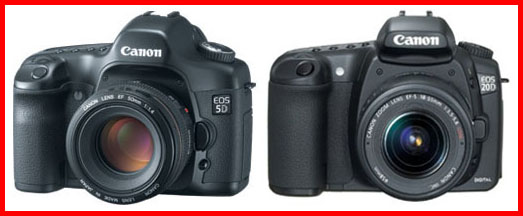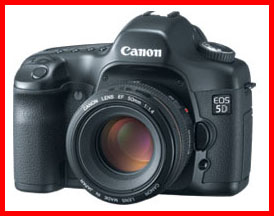JimDoty.com |
||||||||||||||||
|
|
||||||||||||||||
My Other Web Sites
: This site in: |
||||||||||||||||
|
|
||||||||||||||||||||
CANON 20D vs 5D, A FIRST LOOK It isn't fair to compare these two cameras. The Canon 20D is the latest in a succession of "comparable" cameras that began with the D30 (introduced at $3300), the D60 ($2200), the
10D ($1500), and currently the 20D ($1450). Prices on all of these cameras dropped several months after the initial introduction. The Canon 5D is positioned in between the 20D and the "pro-level" 1D series. Still, the
5D is being introduced at about the same price as the D30 was in the fall of 2000. I'm sure a lot of photographers are wondering if they should upgrade from a 20D (or earlier model) to the 5D when it becomes available.
Here are some of the differences, both great and small. I have First of all, the biggest and most important change. 20D: 22.5 x 15.0 mm CMOS sensor 20D: 3504 x 2336 pixels = 8.2 MP (megapixels) The 20D has the same 1.6X field of view crop
as the 10D and Digital Rebels. Due to an image sensor that is smaller than 35mm film, all images are cropped. This means the effective focal length of a lens is 60% longer than when the same lens is used on a 35mm film camera. This is great for long lens work, but not good for wide angle work.
The A little sense and a lot of nonsense has been written about this of late. It is true that digital cameras with a field of view crop use the central and sharpest portion of the image circle. This has given rise to an unnatural fear that going back to a full frame sensor is somehow a disadvantage. Nonsense! On 35m film cameras, our lenses could produce images that could be scanned to make gorgeous 12x18 inch and larger prints. They will do the same with prints from full frame digital sensors. Fish eye lenses will once again provide a 180 degree angle of view. If full frame sensors were as economical to produce as smaller sensors, all digital SLRs would have full frame sensors and this would all be a non-issue today. Shoot a few days with a smaller sensor and shoot a few days with a full frame sensor. If you could then have either camera for free, I bet I know which one you would pick. It is a bit silly that photo forums are filling up with comments about the disadvantages of a full frame sensor. What about the field of view crop when it comes to using long lenses? On a strictly technical, pixel count basis, the 20D has the advantage over a cropped 5D image. 20D: 3504 x 2336 pixels = 8.2 MP (megapixels) **If
you take the same photo with the same lens from the same location with both cameras, and then crop the 5D image down to the size of the 20D image, the 20D image has a 3 megapixel advantage. Not all pixels are created
equal, however. As many photographers discovered 5 years ago, the Canon D30 with a 3 megapixel sensor produced better images than a lot of cameras with 4 and 5 megapixel sensors. It will require actual testing to
see if the 20D's mathematical pixel advantage translates into a real world quality advantage. If you shoot wildlife and other subjects with long lenses and you are trying to get as much reach as possible, the 20D image
MIGHT have an advantage over the cropped 5D image. Side by side testing will tell. 20D: 8.2 megapixel sensor A higher megapixel count means the 5D can produce bigger, high quality enlargements. Not only that, each pixel, or photosite is bigger than the photosites on the 20D which should translate into less noise and more image quality. 20D: $1300 This is no doubt the primary hurdle to choosing the 5D. This is an expensive camera. Still, it is $4600 less than the only other digital camera with a full frame sensor that is still being produced (since Kodak pulled the plug in May on the Kodak DCS Pro/c&n cameras). 20D: 1.8" TFT LCD monitor The LCD viewing screen on the back of the 5D is much bigger which is a nice plus. It will make it easier when reviewing a magnified image to tell if it is adequately sharp.
20D: Luminance histogram This is a big plus for the 5D. The RGB histogram will tell at a glance if any individuals color channels have been blown out. 20D: 5 frames per second Even when shooting sports I rarely use my 20D in rapid fire mode. This is an
advantage but not a big advantage for the 20D. 20D: 23 jpeg frames continuous buffer (6 RAW) I rarely fill the buffer on the 20D. The 5D has a clear advantage for sports and other rapid fire situations provided the slower 3 frames per second isn't a problem. 20D: Center-weighted, evaluative, and partial metering modes The addition of spot metering on the 5D is a huge plus. It is the most accurate form of metering for those who know what they are doing in terms of subject tonality and exposure compensation . 20D: 1/250 X sync A small step backwards for the 5D. This is surprising.
20D: 9 point autofocus system Only testing will tell if this is a real or paper advantage in the autofocusing speed and accuracy department.
20D: Pop up flash So who says a semi-pro camera doesn't need a built in flash? That is my only disappointment with the EOS 3 film camera. A built in flash is less resistant to moisture, but this camera isn't weather sealed anyway. To get that you have to step up to the 1D cameras. The 20D is slightly smaller and lighter by only 0.3 pounds.. The 20D and 5D both have USB 2.0
for faster downloads to a computer. 20D: Takes the new EF-S lenses This is a disadvantage only if you bought a bunch of EF-S lenses. The top deck of the 5D is like the top deck of
the 10D and 20D, and not like the top deck of the 1D series cameras. Having worked with both, I prefer the 10D - 20D style of top deck controls. This is a matter of personal preference. There are other minor changes.
The 20D has more picture modes (some would say "dummy" modes) on the top left dial. The 20D has black and white picture modes that the 5D does not have. I always shoot color and convert to B&W later so this mode is
not important to me. The 5D has more control over image parameters. This may or may not turn out to be a real world advantage. You can read about all of this in detailed reviews as they become available.
So what changes matter?
That will depend on what you shoot and how. Here is how it stacks up for me. Despite other changes, the big story is in the full frame, 12.8 megapixel sensor. Image quality should be a notch higher. You can
crop an image and still have enough pixels to make a large sized, high quality print. That is what makes the price jump from $1300 to $3300 worthwhile. However worthwhile the new features may be, that does not
necessarily make the 5D affordable. Ask anyone who has longed for a 1Ds Mark II but the price is simply out of the question. Spot metering is another plus. Other
improvements (bigger buffer) are nice but not terribly significant. It remains to be seen if having more control over image parameters is a real versus paper advantage. A bigger LCD monitor is a big plus for reviewing
an image. An RGB histogram is a more discriminating tool for checking exposure. Should you buy this camera? That all depends. If you have a 20D now, if the $3300 price tag is not an issue, and if detailed testing shows that
this camera is indeed as good as I think it will be, then it will be a great upgrade. I would still wait before purchasing until reliable and detailed reviews are available and the inevitable early release bugs have
been worked out. If you have Canon EF lenses and you are thinking about switching to digital, it pretty much boils down to price. If price is an issue, and it will be for many, the Canon 20D is a great camera. Older
models like the 10D can be had for really good prices on the used market. The Canon Digital Rebel XT and the older Digital Rebel (used) are both good cameras. Keep in mind, if you want to use the EF-S lenses, that they
won't mount on the 10D, D60, or D30 (or the 5D or 1D series). If you have bunch of Nikon lenses that you are happy with and you want to jump to digital, it would make sense to get a Nikon digital body. This applies
to other brands of cameras also. It doesn't make sense to make a digital camera choice based on the latest and greatest camera of the moment. Someone else will come out with a better camera tomorrow. It is wiser
to choose based on a particular lens system that will meet your needs now and in the future. GOOD LENSES SHOULD LAST A LONG, LONG TIME, DIGITAL BODIES GET REPLACED. If you already have a good collection of lenses that
will serve you well, find a digital body that will work with them. If your lenses are digitally orphaned, or the lens system will not meet your future needs, switch to a lens system that will. If that happens to be the
Canon EF lens system, then a Canon 10D, 20D, or 5D and some fine Canon EF lenses would serve you well. |
 |
|
|
|
August 25, 2005
|




